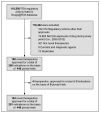Clinical trial evidence supporting FDA approval of novel therapeutic agents, 2005-2012
- PMID: 24449315
- PMCID: PMC4144867
- DOI: 10.1001/jama.2013.282034
Clinical trial evidence supporting FDA approval of novel therapeutic agents, 2005-2012
Abstract
Importance: Many patients and physicians assume that the safety and effectiveness of newly approved therapeutic agents is well understood; however, the strength of the clinical trial evidence supporting approval decisions by the US Food and Drug Administration (FDA) has not been evaluated.
Objectives: To characterize pivotal efficacy trials (clinical trials that serve as the basis of FDA approval) for newly approved novel therapeutic agents.
Design and setting: Cross-sectional analysis using publicly available FDA documents for all novel therapeutic agents approved between 2005 and 2012.
Main outcomes and measures: Pivotal efficacy trials were classified according to the following design features: randomization, blinding, comparator, and trial end point. Surrogate outcomes were defined as any end point using a biomarker expected to predict clinical benefit. The number of patients, trial duration, and trial completion rates were also determined.
Results: Between 2005 and 2012, the FDA approved 188 novel therapeutic agents for 206 indications on the basis of 448 pivotal efficacy trials. The median number of pivotal trials per indication was 2 (interquartile range, 1-2.5), although 74 indications (36.8%) were approved on the basis of a single pivotal trial. Nearly all trials were randomized (89.3% [95% CI, 86.4%-92.2%]), double-blinded (79.5% [95% CI, 75.7%-83.2%]), and used either an active or placebo comparator (87.1% [95% CI, 83.9%-90.2%]). The median number of patients enrolled per indication among all pivotal trials was 760 (interquartile range, 270-1550). At least 1 pivotal trial with a duration of 6 months or greater supported the approval of 68 indications (33.8% [95% CI, 27.2%-40.4%]). Pivotal trials using surrogate end points as their primary outcome formed the exclusive basis of approval for 91 indications (45.3% [95% CI, 38.3%-52.2%]), clinical outcomes for 67 (33.3% [95% CI, 26.8%-39.9%]), and clinical scales for 36 (17.9% [95% CI, 12.6%-23.3%]). Trial features differed by therapeutic and indication characteristics, such as therapeutic area, expected length of treatment, orphan status, and accelerated approval.
Conclusions and relevance: The quality of clinical trial evidence used by the FDA as the basis for recent approvals of novel therapeutic agents varied widely across indications. This variation has important implications for patients and physicians as they make decisions about the use of newly approved therapeutic agents.
Conflict of interest statement
Figures
Comment in
-
Opening the FDA black box.JAMA. 2014 Jan 22-29;311(4):361-3. doi: 10.1001/jama.2013.283946. JAMA. 2014. PMID: 24449313 No abstract available.
-
Quality of evidence behind FDA approvals varies widely.BMJ. 2014 Jan 27;348:g1075. doi: 10.1136/bmj.g1075. BMJ. 2014. PMID: 24470635 No abstract available.
-
Trial evidence and approval of therapeutic agents.JAMA. 2014 May;311(20):2128-9. doi: 10.1001/jama.2014.3401. JAMA. 2014. PMID: 24867019 No abstract available.
-
Trial evidence and approval of therapeutic agents--reply.JAMA. 2014 May;311(20):2129. doi: 10.1001/jama.2014.3420. JAMA. 2014. PMID: 24867021 No abstract available.
References
-
- Schwartz LM, Woloshin S. Communicating uncertainties about prescription drugs to the public: a national randomized trial. Arch Intern Med. 2011;171(16):1463–1468. - PubMed
-
- Zhang J, Zhang H, Yu CH, Li JY, Jiang Y. The attitudes of oncology physicians and nurses toward phase I, II, and III cancer clinical trials. Contemp Clin Trials. 2011;32(5):649–653. - PubMed
-
- Chen DT, Wynia MK, Moloney RM, Alexander GC. US physician knowledge of the FDA-approved indications and evidence base for commonly prescribed drugs: results of a national survey. Pharmacoepidem Dr S. 2009;18(11):1094–1100. - PubMed
-
- Healy D. Pharmageddon. Berkeley and Los Angeles, California: University of California Press; 2012.
-
- Anderson GM, Juurlink D, Detsky AS. Newly approved does not always mean new and improved. JAMA. 2008;299(13):1598–1600. - PubMed
Publication types
MeSH terms
Substances
Grants and funding
LinkOut - more resources
Full Text Sources
Other Literature Sources


